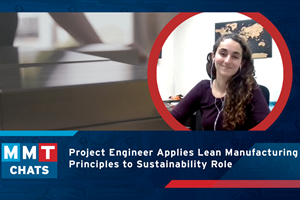Keeping Up with ISO: Minimize Risk in Value-Chain Partnerships
In addition to ISO 9001:2015 certification, there are a variety of ways that U.S. manufacturers can lower product-quality risks.
OEMs today are looking for partners that completely embrace their business philosophies and production goals. They also are looking to form long-term relationships with key vendors and customers that work to increase efficiency, trim costs and improve global competitiveness. The ISO 2015 revisions can help U.S. moldmakers and molders fit this bill, giving them the well-versed industrial management background OEMs desire. The revision includes standards for safety, quality, production, maintenance, problem-solving, organizational skills and leadership.
In addition to ISO 9001:2015 certification, U.S. manufacturers can lower product-quality risks with lifetime tooling guarantees, zero-defects manufacturing models, adherence to U.S. manufacturing laws and regulations, Occupational Safety and Health Administration certification, and resin-source certification. They also can reduce supply-chain risks by securing just-in-time deliveries, instead of international ones that can take 45 days, as well as same-day order revisions. Working with U.S. suppliers also means payment risks are lessened due to currency stability, sales being conducted in U.S. dollars, open payment terms, tool financing programs for qualified customers, protection of all intellectual property rights, complete adherence to non-disclosure agreements and patent protection. Communication also is improved, as there typically are no significant language or time zone barriers. Lastly, U.S. moldmakers and molders can speed up every phase of a manufacturing operation, as a local supplier can fix issues more quickly, creating a win-win relationship.
To fully understand the true cost of this domestic value-chain relationship, OEMs must consider the differences between the price of a product and the cost of manufacturing it, outsourcing and in-house production, and working with a supplier and a true development partner. ISO helps determine this true cost by calculating total cost of ownership (TCO), a financial estimate intended to help buyers and owners determine both the direct and indirect costs of a product or system.
True Cost and Minimized Risk
Some would say an OEM approach to TCO is trying to get low-ball prices from each supplier, but still demanding vertical integration and value-added operations to improve price, efficiency and product quality. To avoid jeopardizing quality, a better approach is to understand the offshore vs. domestic considerations, which include materials, molds, mold components, molding and the assembled finished products. They should also consider the “soft” benefits of doing business in the United Sates mentioned above, which include easier communication, faster response times, and few language or time-zone complications.
The ISO 9001:2015 revisions discussed to date in this column help to support the value of domestic partners by requiring companies to demonstrate measurable performance improvements, thereby minimizing risk. Here are eight best practices:
Risk management. Ensure all corrective actions (internally, and by customers and suppliers) are on track to meet their due dates. Keeping up with overdue corrective actions is a common challenge. Having in place a system that provides notification and escalation of due dates can really help.
Supplier approval teams. Establish a buyer and ISO team that provides a certificate of analysis with every shipment received, manages protection of all intellectual property rights, stays on top of certifications for resins/metals/other primary materials. Sources for these certifications include the U.S. Food and Drug Administration, International Organization for Standardization, Restriction of Hazardous Substances, Underwriters Laboratories, the American Society for Testing Materials, International Traffic in Arms Regulations, just-in-time manufacturing and OSHA.
Business measures. Monitor the following measures: financial (return on investment), quality (scrap, rework, returns), customers (customer survey), productivity (yield-trends), workforce (team building, employee and management motivation), market (increased customer base, satisfaction and perception), vendors (supplier scorecard), environmental (water/electric/gas usage, hazardous waste disposal), recycling (paper, plastics, metals, cardboard) and safety (accidents, days/time off).
Improvement/value-stream mapping. Create a diagram that shows the material, equipment, employee and information flow needed to convert a customer order into the delivery of the product, and then create a future map that will identify potential improvements, including costs and waste reductions.
5S system. Implement sort, set in order, shine, standardize and sustain as your working tool for ISO 9001:2015. This improves workplace efficiency and safety throughout the organization.
Employee suggestions. Solicit process improvement recommendations using a form that includes the idea, improvement, problem, action taken, completion date, and employee and management signatures.
Internal auditing. Benchmark operations to identify and quantify opportunities; compare alternative equipment and infrastructure strategies to maximize plant efficiency; validate plant layouts and design alternatives through modeling; and use supply chain report cards and customer surveys.
Management review. Commit to continuous improvement, championed by the CEO/owner, who is also responsible for operating metrics and prioritizing projects to optimize plant performance.
The revised ISO 9001:2015 quality management system standard is a vast improvement from the earlier versions and serves as a concise model for a high-performance organization. However, it is just a model. It is meant to be built upon in order to create a quality management system that propels the organization to optimal performance, making the company a preferred value-chain partner.
Related Content
Treatment and Disposal of Used Metalworking Fluids
With greater emphasis on fluid longevity and fluid recycling, it is important to remember that water-based metalworking fluids are “consumable” and have a finite life.
Read MoreStrategies for Delivering a Qualified Talent Pipeline for Manufacturers
Insights into the importance of talent in maintaining national competitiveness, the impact of global events on the workforce and practical strategies for developing and implementing effective talent plans.
Read MoreMMT Chats: Project Engineer Applies Lean Manufacturing Principles to Growing Sustainability Role
MoldMaking Technology Editorial Director Christina Fuges catches up with MMT’s 30-Under-30 Honoree Katherine Pistorius, who has added Regional Sustainability Coordinator alongside her Project Engineer duties, which demonstrates the many paths one can take in a manufacturing career. Here she shares how this opportunity unfolded for her and what the job entails today and in the future. This episode is brought to you by ISCAR with New Ideas for Machining Intelligently.
Read MoreCertified Quality Management for Plastics Professionals – Materials to Tooling to Recycling
Why is certification of a shop’s quality management system to ISO 9001, AS9100, IATF 16949 or ISO 13485 so special? What does the certification signify? And what supports the paper behind the framed certificate?
Read MoreRead Next
How to Use Strategic Planning Tools, Data to Manage the Human Side of Business
Q&A with Marion Wells, MMT EAB member and founder of Human Asset Management.
Read MoreHow to Use Continuing Education to Remain Competitive in Moldmaking
Continued training helps moldmakers make tooling decisions and properly use the latest cutting tool to efficiently machine high-quality molds.
Read MoreAre You a Moldmaker Considering 3D Printing? Consider the 3D Printing Workshop at NPE2024
Presentations will cover 3D printing for mold tooling, material innovation, product development, bridge production and full-scale, high-volume additive manufacturing.
Read More




















